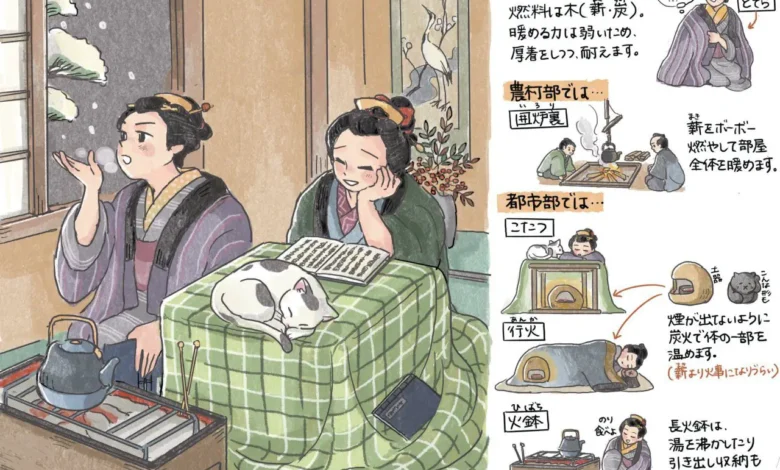Traditional Japanese ways to remain warm and save energy

People have long admired Japan for its unique blend of innovation and tradition. In the face of cold winters, the Japanese have developed ingenious methods to stay warm while conserving energy. The following are traditional Japanese ways to remain warm and save energy, highlighting practices such as the use of kotatsu, futon bedding, and architectural designs. These methods not only provide comfort and warmth but also reflect a deep respect for resourcefulness and sustainability in Japanese culture.
Yutanpo water heater
“湯湯婆 – Yutanpo” originated in China, was introduced to Japan in the Muromachi period (1336–1573), and is still popular today.
They are containers made of metal, ceramic, or plastic that are filled with hot water to warm the body. This is a basic heating device that may be positioned at the waist, abdomen, or end of the bed to keep the body warm and can also be used in heat therapy.
Yutanpo is a traditional heating device that is less expensive than other heaters and costs less to run. Unlike other heaters, Yutanpo doesn’t need electricity or fire to make heat. This means it’s safe because it can’t start a fire. It also doesn’t make the air inside dry or dirty, and you can easily carry it around.
But, you have to be careful when using Yutanpo. Sometimes, the bottle can break because it gets old, or the lid can get damaged. Also, if it touches your skin for too long, even though it’s not very hot, it can still cause burns.
Recently, new types of Yutanpo bottles have been made. These bottles have special parts that keep heat for a long time. You can heat them up in the microwave or with an electric charger. This makes them even more convenient to use. So, Yutanpo is a great way to stay warm, save money, and be safe at the same time. But remember to use it carefully!
Warm pads
Today, a warming patch is seen as a small tool that can be used to warm up anywhere, anytime. It’s a great help to fight the cold during the harsh winter.
These heating pads work by causing metals to react with oxygen to make heat. The main parts of the warm patches are iron powder, salt, activated carbon, and water. These are all sealed inside a special fabric. When you open the package, the patch starts to heat up.

Most warm patches can reach a temperature of 40 to 60 degrees Celsius. They can keep giving off heat for about 15 hours, depending on the type of patch. There are both sticky and non-sticky types.
These patches can be used by anyone, from kids to older people. But to avoid burning the skin, they should be stuck to clothes, not directly on the skin.
In Japan, there are many good brands of warming patches. Some of them are Kairo, Salonpas, Jikabari Hisamitsu, and Okamoto. So, you have many options to choose from. Remember to use them safely!
Kotatsu heating table
“炬燵 – Kotatsu” is a heating appliance with a history lasting more than 500 years. This gadget has a pretty simple structure, consisting of merely a low wooden table with a heat source from a heater put under the table and covered with a cotton blanket or futon mattress on top to prevent heat from escaping.
Kotatsu heaters are claimed to come from the practice of using Irori stoves in traditional Japanese dwellings. These stoves are typically used for cooking and are a source of heat to keep the whole house warm.

The first type of the Kotatsu heating table originated around the 14th century, named Horigotatsu, with a structure of a wooden frame and a cotton blanket placed on top, utilized as a fireplace situated in the center of a dwelling.
In the past, charcoal and other fuels were utilized as heat sources, but currently electrical appliances have steadily replaced them. Kotatsu is now portable and an essential tool in every Japanese household.

The whole family sitting around a Kotatsu, having supper, and watching TV together is a warm, traditional way to spend a chilly winter in Japan. In recent years, small Kotatsu for one person have become accessible.
Hibachi Charcoal Furnace

“火鉢 – Hibachi” is a ceramic, metal, or wood utensil that has been used in Japan since the Nara period around the 700s for heating, boiling water, and cooking simply by inserting ashes and burning charcoal within.
People are utilizing hibachi braziers less and less as heating technologies such as electric stoves grow increasingly common. However, the crackling sound of burning coals, the peculiar perfume, and the beauty of the brazier for delivering mental peace have prompted some Japanese to buy them at flea markets and antique markets and start using them again.
Kimono Dotera

They are especially beneficial in Hokkaido and the Tohoku region, where the climate is severely cold. This warm kimono is still routinely given at Japanese-style inns.






